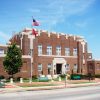calsfoundation@cals.org
Charles Sumner Duke (1879–1952)
A trailblazing African-American architect and engineer, Charles Sumner Duke not only designed unique public structures, but he also fought for housing rights and educational opportunities for African Americans. His powerful legacy continues in the buildings he designed, as well as in the organization he formed to facilitate the development of engineering and technological skills in youth of color.
Charles Sumner Duke was born in Selma, Alabama, on July 21, 1879. His father, Jesse Duke, was the editorial writer and publisher for a local newspaper, The Herald. His mother, Willie Black Duke, was from a family of established businessmen. It was a financially secure family, allowing Duke and his siblings to take advantage of opportunities that many others in the black community could not, such as attending private school. However, after a stinging article by Duke’s father in his newspaper denouncing the lynching of blacks, the family was run out of town.
When the family arrived in Pine Bluff (Jefferson County) in the late 1880s, Duke’s father launched another newspaper, The Herald, and later worked with activist Ida B. Wells in challenging lax enforcement of state laws regarding lynchings. The Duke family became well respected in Pine Bluff. Jesse Duke built a large home three miles outside the city limits and became engaged in church activities and community issues. The family—which included Duke and his mother and father, three brothers, a grandfather (Abner), a grandmother (Mary Jane), uncles (Noah and Green), and aunts (Charlotte and Willie)—became an integral part of the area’s black middle class, involving themselves in social organizations and school functions.
By the 1890s, Duke had graduated from high school at Branch Normal College, now the University of Arkansas at Pine Bluff (UAPB). He then enrolled at Harvard University and eventually became the first African American to earn a Bachelor of Arts in mathematics at the institution. He also went on to complete a Master of Science in civil engineering, becoming the first African American to do so there as well.
By 1908, Duke had married Estelle Taylor and moved to Chicago, Illinois. In 1913, the Chicago Department of Public Works employed Duke to serve as its first black engineer draftsman. In 1920, Duke became licensed in Illinois in both architecture and engineering.
Duke started an architectural engineering consulting firm in 1922. This gave rise to several projects, including three churches, a nursing home, hotels, and several houses in Chicago. Duke’s most prominent project may have been his work as a project engineer for the eight-story Knights of Pythias building designed by Walter Thomas Bailey. The building, according to some sources, was the tallest building at the time to have been built by African Americans and cost about $1 million. It used Egyptian motifs detailing the building’s exterior, boasted a 1,500-seat theater and a rooftop garden, and served as a source of pride for Chicago’s black community.
By the late 1920s, Duke was also pursuing housing opportunities for African Americans to lift them out of poverty. He was appointed in 1926 by the mayor of Chicago, Bill Thompson, as the only black member of the Chicago Zoning Commission. Two years later, he was appointed to President Herbert Hoover’s Commission on Public Housing, later securing funding to build the first housing project in Chicago, the Ida B. Wells Homes.
In 1925, concerned about expanding opportunities for young people of color in science, math, engineering, and technology, he brought together black scientists and engineers to found the National Technical Association. The organization continues in the twenty-first century to serve as a voice for minorities in promoting opportunities in these fields as well as providing mentoring and training.
Duke worked with the U.S. Resettlement Bureau, overseeing one of the largest staffs of black architects in the United States. He designed housing projects throughout the South, and, in 1946, he became the supervising engineer with the U.S. Virgin Islands Public Works Administration, overseeing a $10 million, five-year capital-improvement project.
Duke died on June 15, 1952, in Rochester, Minnesota, from complications related to a blood clot after surgery for cancer.
For additional information:
Billingsley, Andrew. Climbing Jacob’s Ladder: The Enduring Legacies of African American Families. New York: Touchstone, 1992.
Carter, Elmer A. “Charles Sumner Duke, C.E.” Opportunity Magazine (April 1942): 16.
“Charles S. Duke.” Journal of Negro Life (April 1932): 117.
Wilson, Dreck Spurlock, ed. African-American Architects: A Biographical Dictionary, 1865–1945. New York: Routledge, 2004.
Jimmy Cunningham
Nashville, Tennessee
 Early Twentieth Century, 1901 through 1940
Early Twentieth Century, 1901 through 1940 Public Works Administration
Public Works Administration Science and Technology
Science and Technology




Comments
No comments on this entry yet.